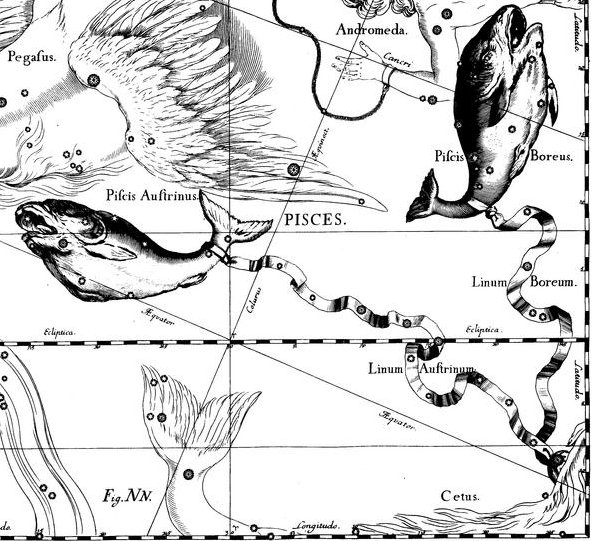2. A quadruped - e.g. a horse - can signify summer ('land') because of its high sky, presumably supported by 4 pillars (like legs), one in each corner. And if a whale is a kind of fish, which earlier was established fact, then a stag would certainly have been regarded as a kind of horse. The Stag indicates the arrival of 'fire' at the beginning of the summer 'year':
Close by we can see the Rainbow, another sign of the arrival of Sun. Hevelius has pictured Andromeda with the winged horse Pegasus at left and with the pair of Triangles at right, which means time is running from left to right:
The Northern Fish (Boreus Piscis) is touching the back of Andromeda:
With time running from left to right Hevelius was forced to turn Andromeda away from us, otherwise her left foot would have been higher than her right foot (which would have been absurd because left should be lower than right). Perhaps there is a connection between Andromeda seen from the outside of the celestial globe (when time is running from left to right, when her back is up towards the viewer) and the peculiar way Papa-tu'a-nuku was turned face down: ... With the two axes, which were later brought by the Maoris from their far western homeland and used for 'felling' the tempests on some of their famous voyages, Tane severed the arms of his father Rangi. By the powerful incantations of another brother Tane raised Rangi high above the earth, where he still floats. Then Rangi lamented for his wife and his tears fell incessantly while Papa, with her youngest godling still at the breast, moaned and stormed at the cruelty of her sons. Clouds, mists, rain, frost, and driving snow enveloped earth and sky to the great discomfort of the gods. To remedy the situation they turned Papa over so that she faced the Underworld and could no longer look up at Rangi. Thus the youngest child grew up to manhood in the region beneath the earth and became the ruler of earthquakes and volcanic fires with which he still wages war on the upper world in revenge for the inhuman treatment of his parents ... Maybe Andromeda personifies the rock (papa) to which she is chained:
And maybe she is connected with Venus - see the sign close to Anunitum - and as such pregnant with the future Sun king:
In the Mul-Apin text (cfr at Metallah) the 'star' Anunitum (alias τ Piscium according to Wikipedia) is the 3rd on the Path of Anu:
"Though Andromeda has its roots most firmly in the Greek tradition, a female figure in Andromeda's place appeared in Babylonian astronomy. The stars that make up Pisces and the middle portion of modern Andromeda formed a constellation representing a fertility goddess, sometimes named as Anunitum or the Lady of the Heavens." (Wikipedia) With 'behind' in the Mul-Apin text evidently is meant 'later than', e.g. that Anunitum is rising later than the Swallow and the Hired Man even later. A meteor 'shower' seems to originate from Andromeda: "In November, the Andromedids meteor shower appears to radiate from Andromeda. It peaks in mid- to late-November every year, but has a low peak rate of less than three meteors per hour. Astronomers have often associated the Andromedids with Biela's Comet, a comet that was destroyed in the 19th century, but this connection is somewhat disputed. Andromedid meteors are known for being very slow, and the shower itself is considered to be diffuse, as meteors can be seen coming from nearby constellations as well as Andromeda itself. Andromedid meteors sometimes appear as red fireballs. The Andromedids were also associated with the most spectacular meteor showers of the 19th century. The storms of 1872 and 1885 were estimated to have a peak rate of two meteors per second, prompting one Chinese astronomer to compare the meteors to falling rain." (Wikipedia) |
|||||||||||||||||||||||||||||||||||||||||||


